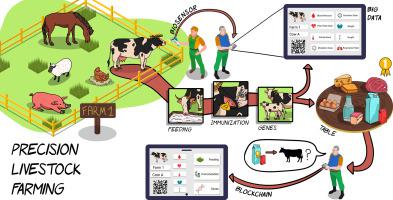Sensing and Bio-Sensing Research ( IF 5.4 ) Pub Date : 2021-02-27 , DOI: 10.1016/j.sbsr.2021.100408 Suresh Neethirajan , Bas Kemp

|
As the global human population increases, livestock agriculture must adapt to provide more livestock products and with improved efficiency while also addressing concerns about animal welfare, environmental sustainability, and public health. The purpose of this paper is to critically review the current state of the art in digitalizing animal agriculture with Precision Livestock Farming (PLF) technologies, specifically biometric sensors, big data, and blockchain technology. Biometric sensors include either noninvasive or invasive sensors that monitor an individual animal’s health and behavior in real time, allowing farmers to integrate this data for population-level analyses. Real-time information from biometric sensors is processed and integrated using big data analytics systems that rely on statistical algorithms to sort through large, complex data sets to provide farmers with relevant trending patterns and decision-making tools. Sensors enabled blockchain technology affords secure and guaranteed traceability of animal products from farm to table, a key advantage in monitoring disease outbreaks and preventing related economic losses and food-related health pandemics. Thanks to PLF technologies, livestock agriculture has the potential to address the abovementioned pressing concerns by becoming more transparent and fostering increased consumer trust. However, new PLF technologies are still evolving and core component technologies (such as blockchain) are still in their infancy and insufficiently validated at scale. The next generation of PLF technologies calls for preventive and predictive analytics platforms that can sort through massive amounts of data while accounting for specific variables accurately and accessibly. Issues with data privacy, security, and integration need to be addressed before the deployment of multi-farm shared PLF solutions becomes commercially feasible.
中文翻译:

数字畜牧业
随着全球人口的增加,畜牧业必须适应提供更多的畜产品和更高的效率,同时还要解决对动物福利,环境可持续性和公共卫生的关注。本文的目的是通过精确的畜牧业(PLF)技术(尤其是生物识别传感器,大数据和区块链技术)来批判性地回顾数字化农业的最新技术。生物识别传感器包括非侵入式传感器或侵入式传感器,它们可以实时监控单个动物的健康和行为,从而使农民能够整合这些数据以进行种群水平的分析。来自生物识别传感器的实时信息使用大数据分析系统进行处理和集成,该系统依靠统计算法对大型,复杂的数据集为农民提供了相关的趋势模式和决策工具。启用传感器的区块链技术可确保从农场到餐桌的动物产品的安全性和可追溯性,这是监控疾病暴发,防止相关经济损失和与食品相关的健康大流行的主要优势。多亏了PLF技术,畜牧业才有可能通过提高透明度和增强消费者信任度来解决上述紧迫的问题。但是,新的PLF技术仍在发展,核心组件技术(例如区块链)仍处于起步阶段,并且尚未得到大规模验证。下一代PLF技术需要预防性和预测性分析平台,这些平台可以对大量数据进行分类,同时又可以准确,方便地考虑特定变量。在部署多服务器共享PLF解决方案变得商业可行之前,必须解决与数据隐私,安全性和集成有关的问题。











































 京公网安备 11010802027423号
京公网安备 11010802027423号